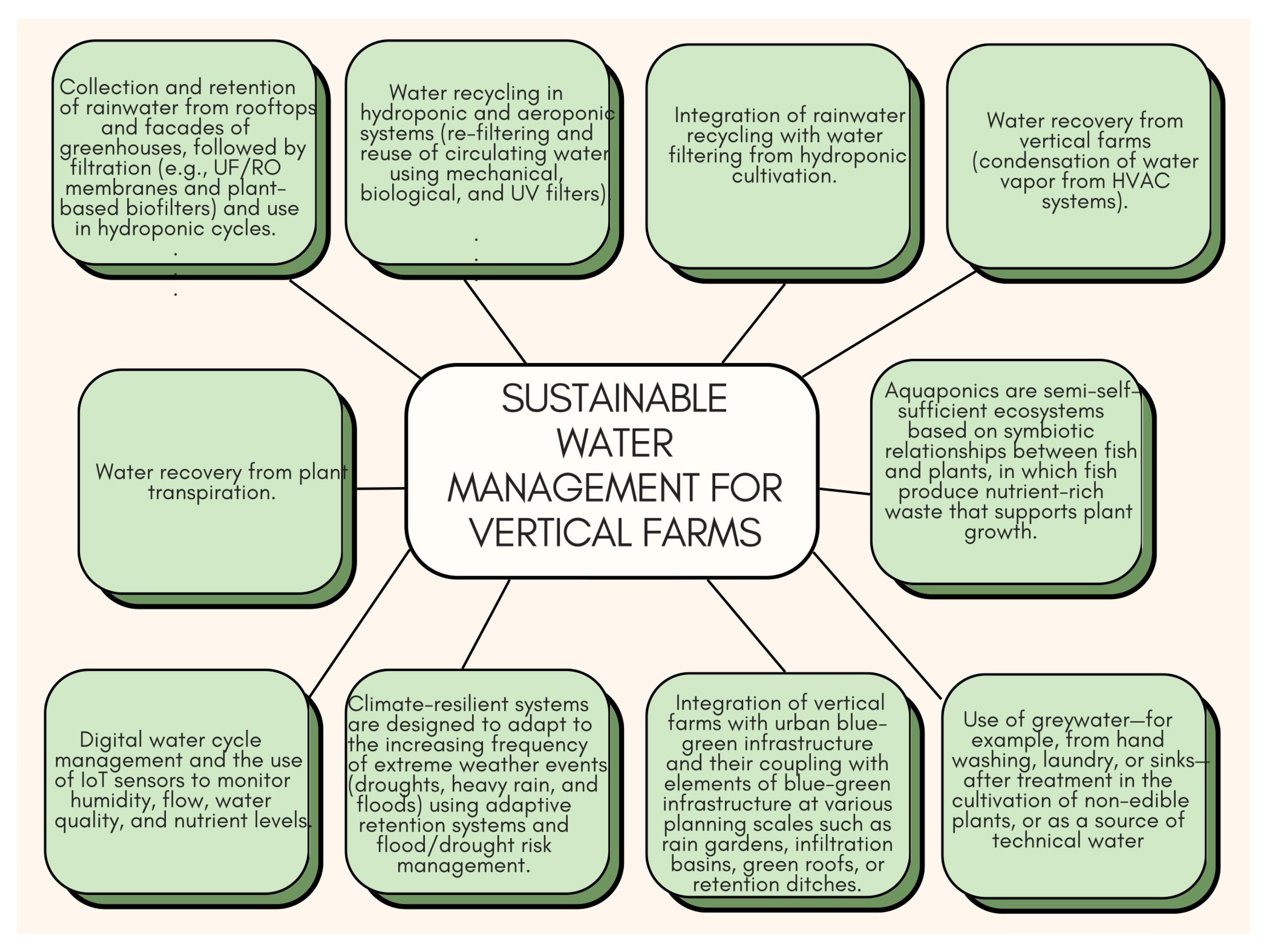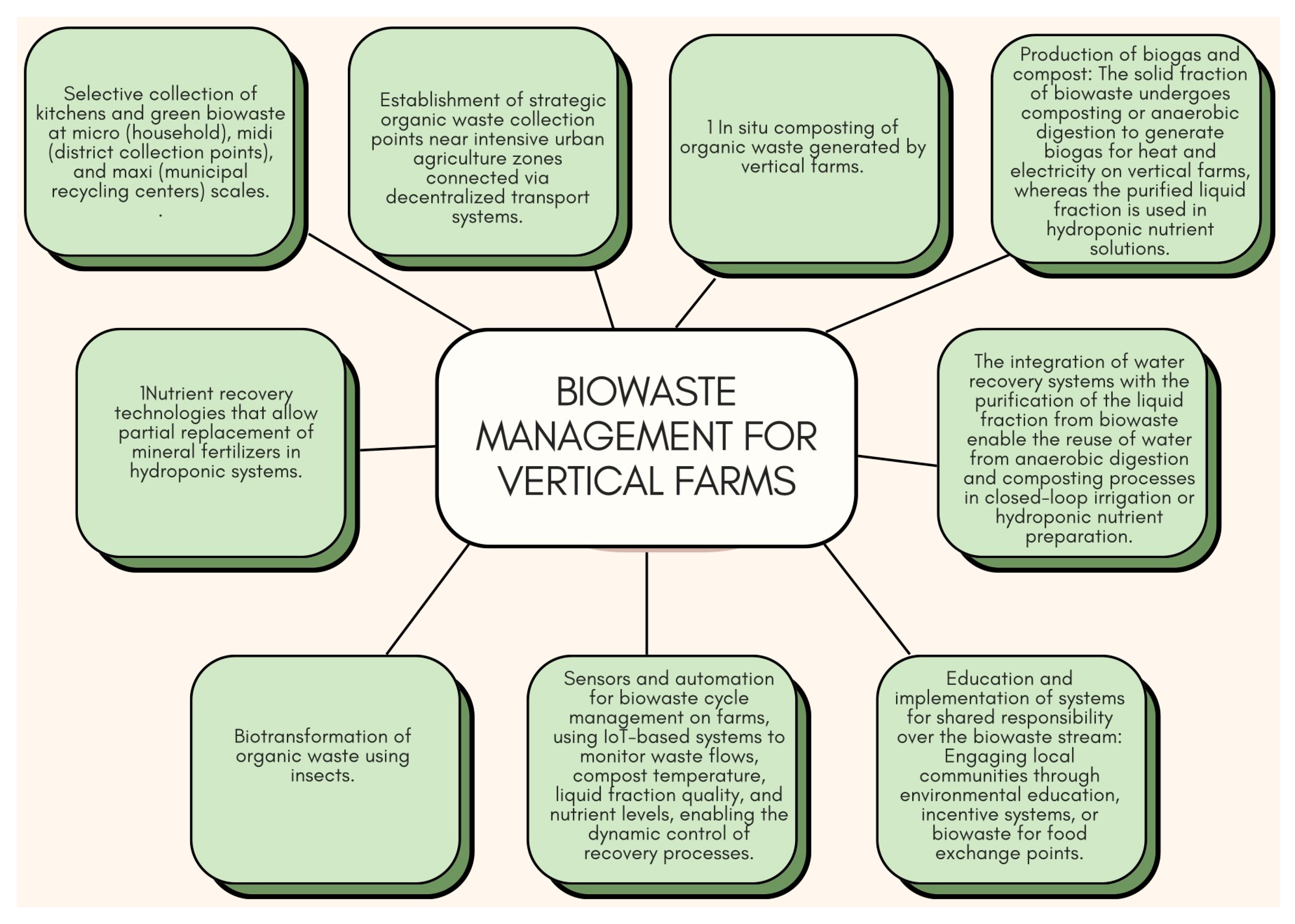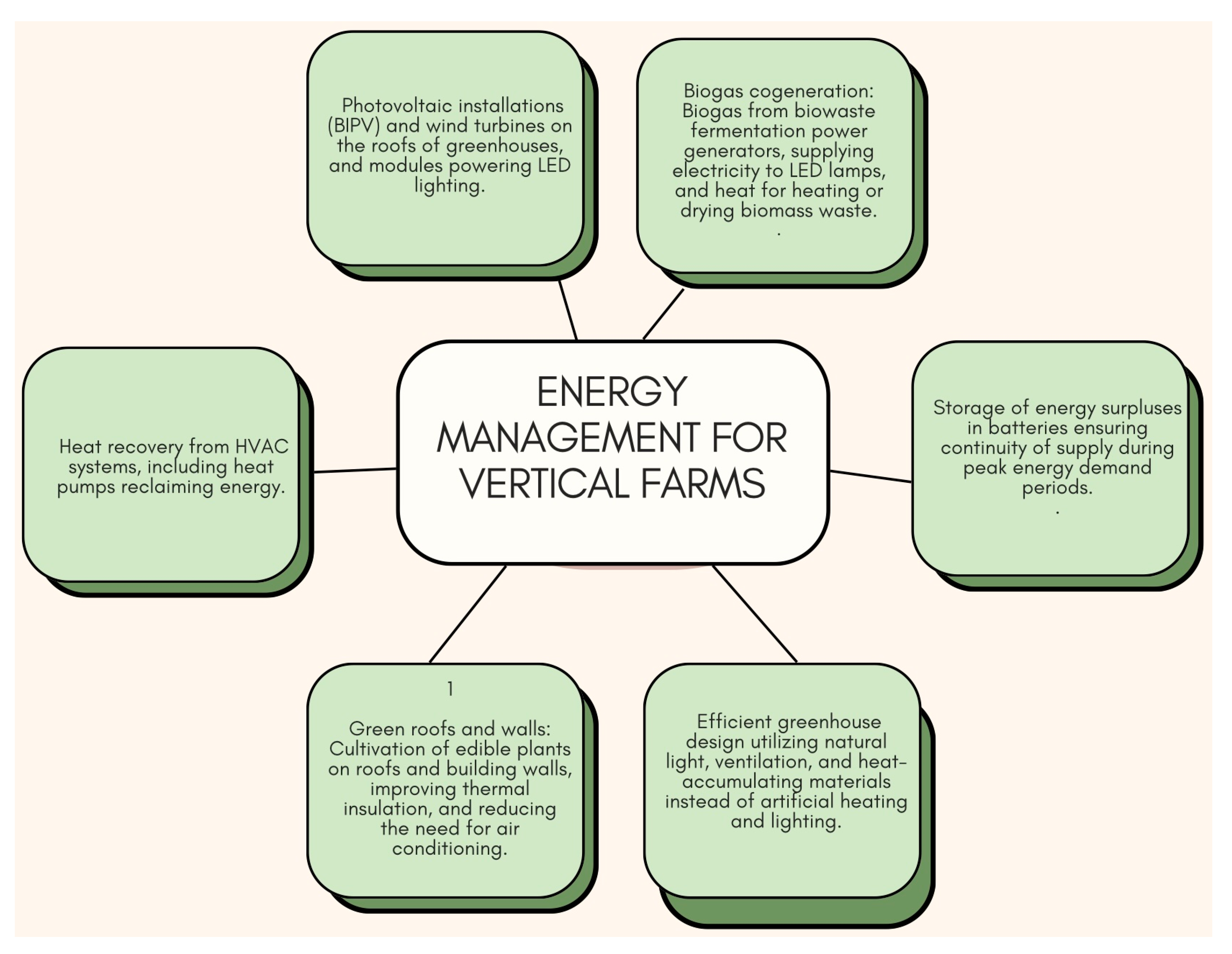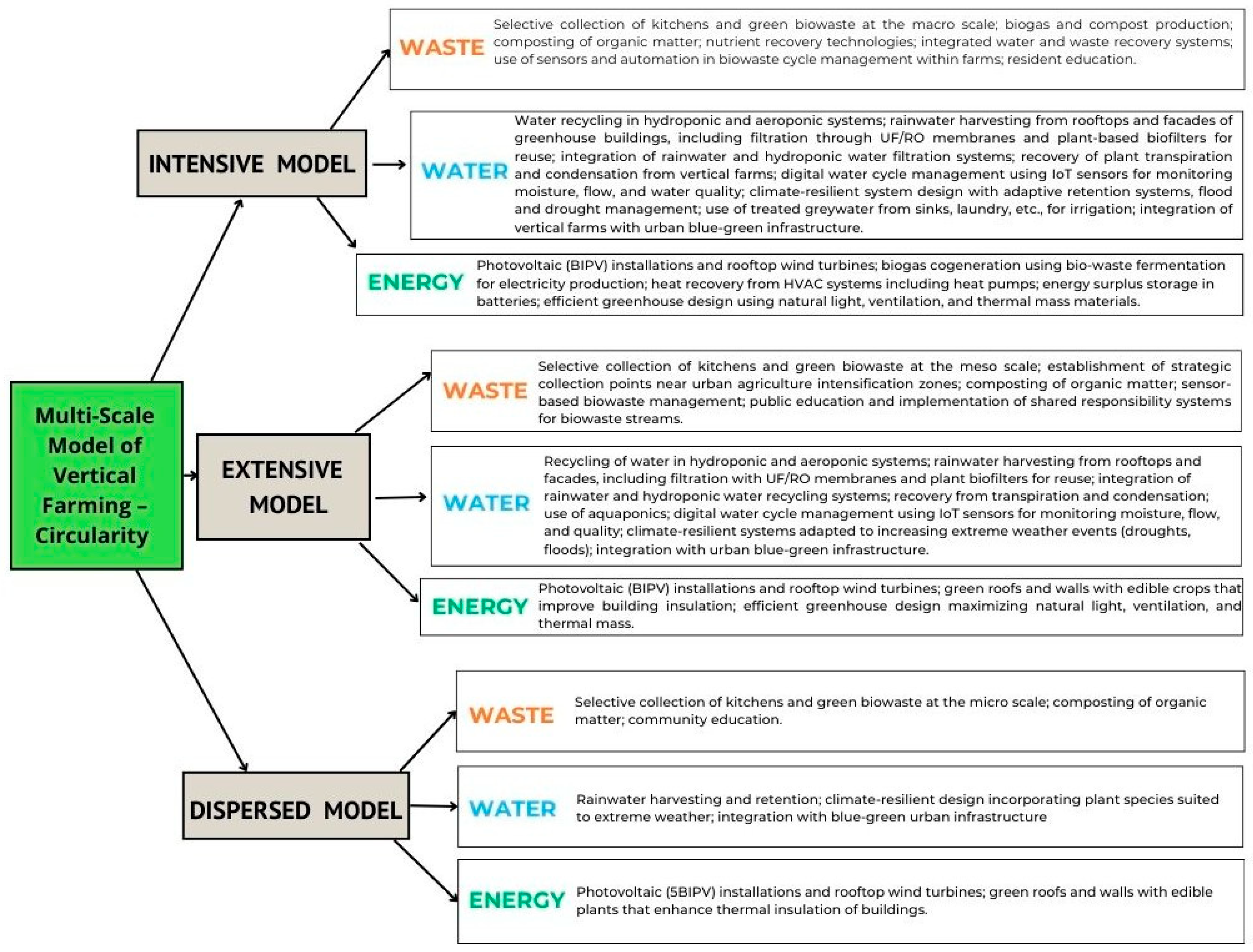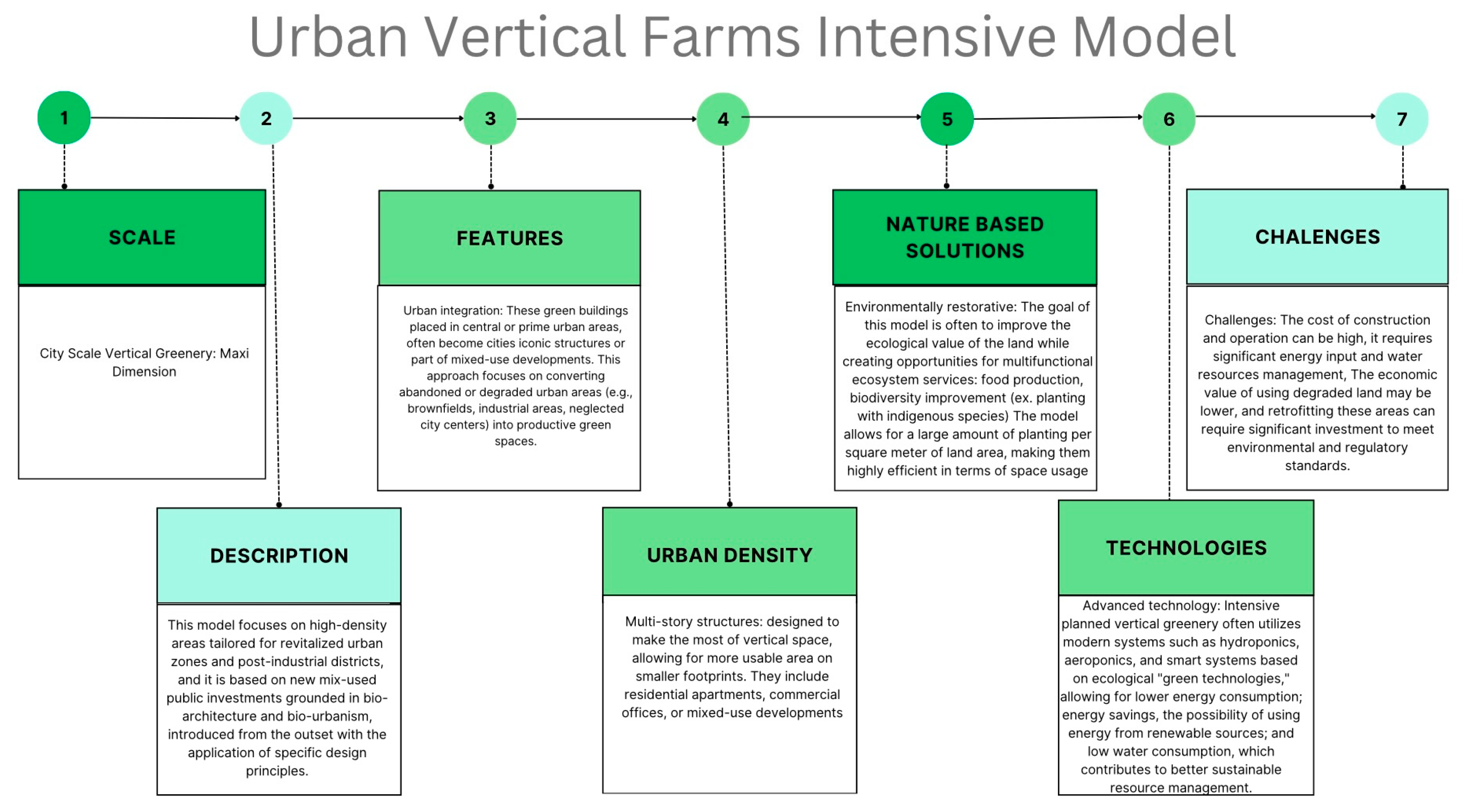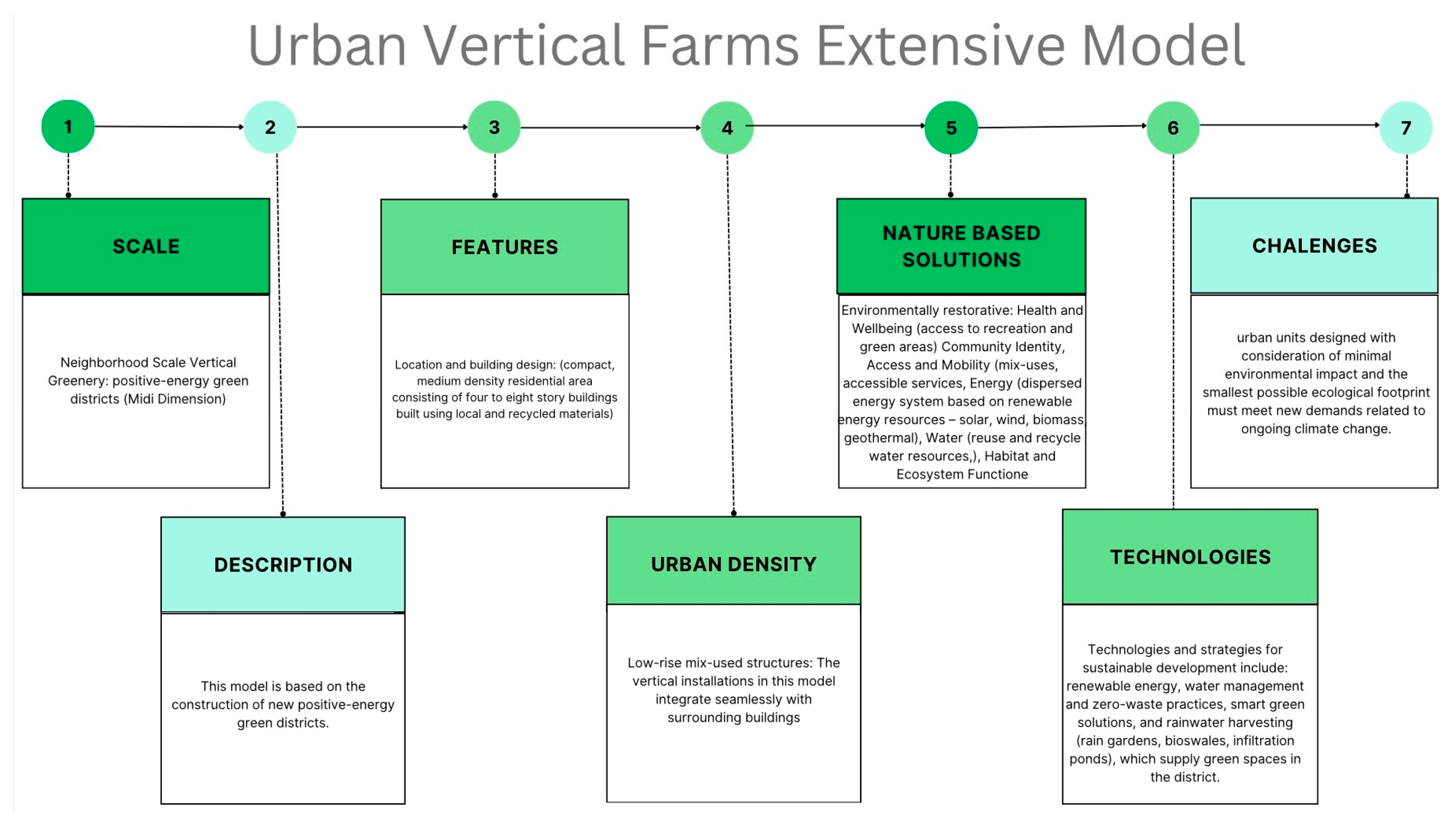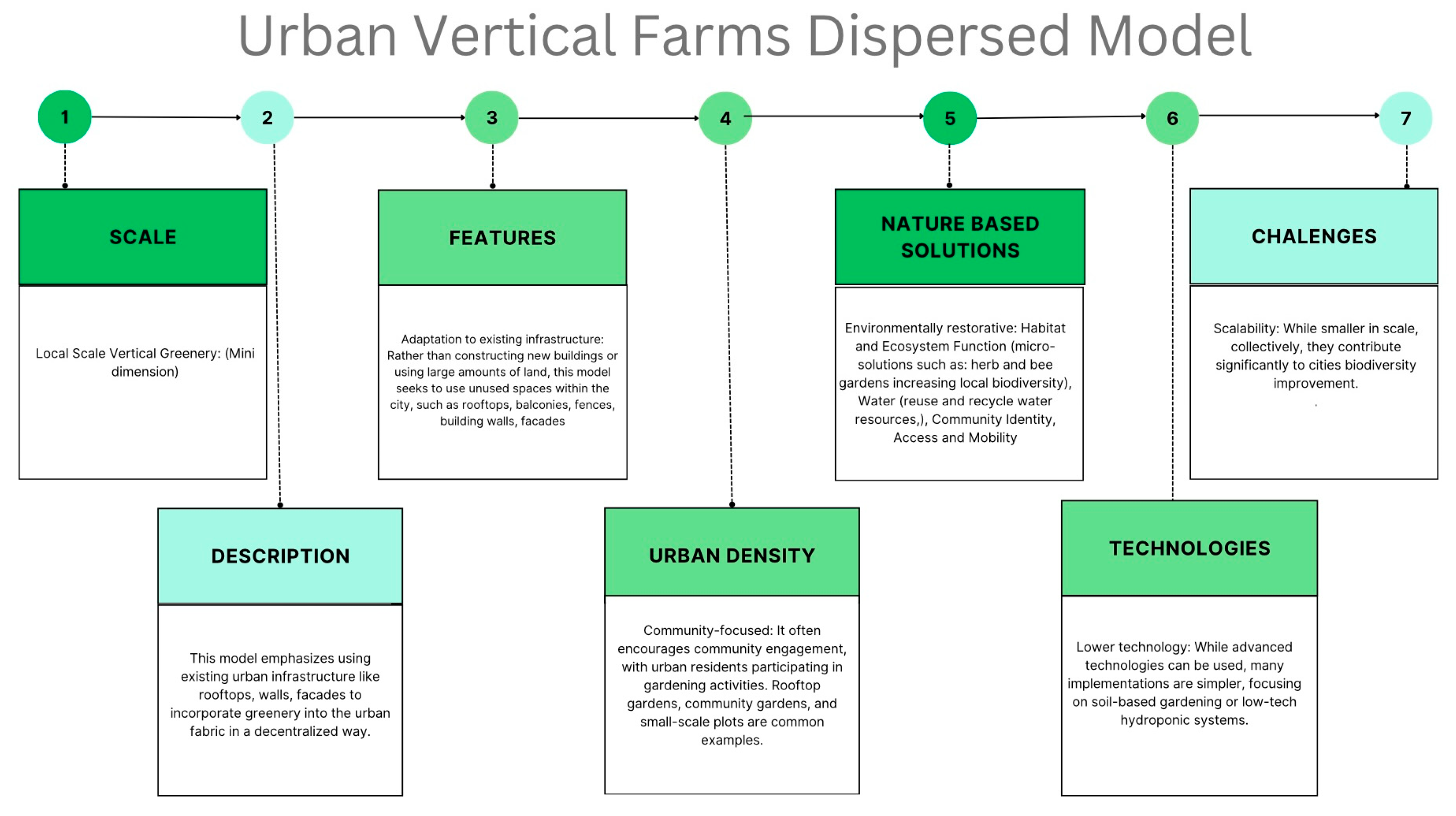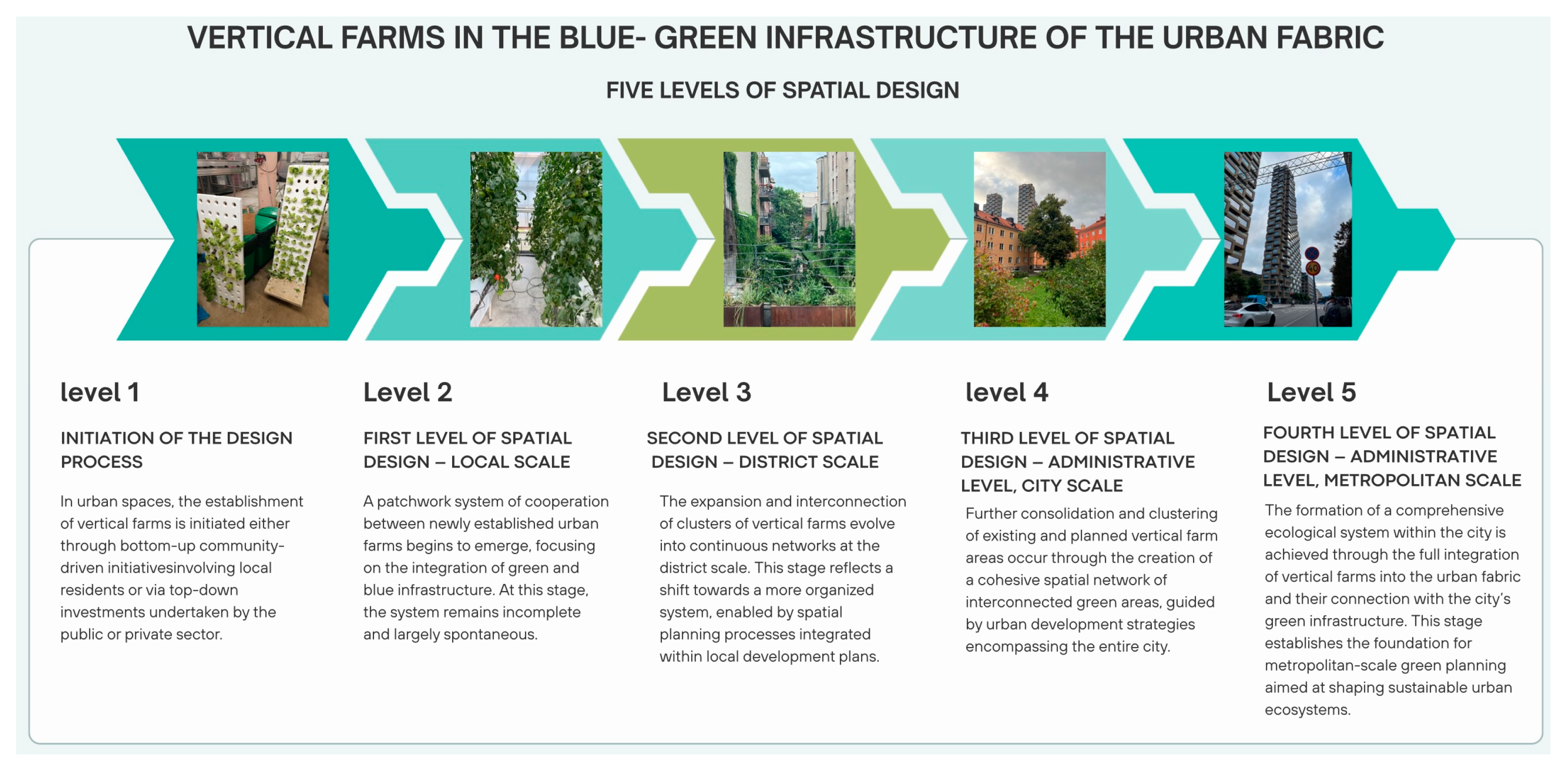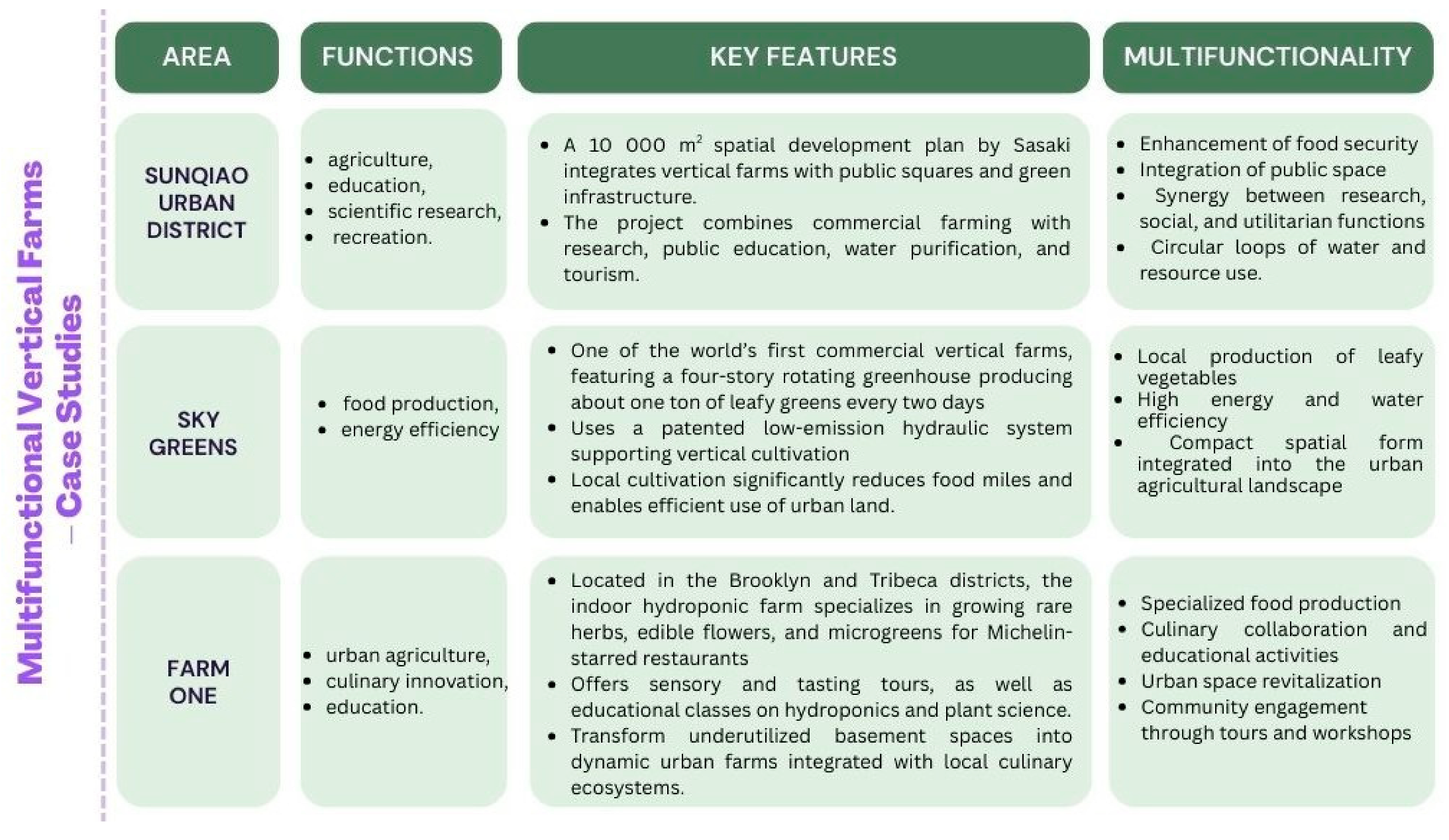1. Introduction
In 2015, approximately 55% of the world’s population (and nearly 75% of Europeans) were living in cities or large urban agglomerations. According to forecasts by the United Nations, by 2050 the proportion of the urban population is expected to rise to over 66% globally and 82% in Europe [
1,
2]. Urbanization is not necessarily correlated with an improvement in the quality of the natural environment. In many countries, green areas are being reduced, air and water pollution levels are increasing, habitat fragmentation is leading to loss of biodiversity, and forest cover is systematically decreasing [
3]. Strong demographic growth is projected to continue in many developing countries in Africa, South Asia, and South America. According to UN data, by 2100 the global population could exceed 21 billion [
4]. Moreover, approximately 80% of the world’s arable land is already in use, and the remaining 20% often consists of degraded areas that are unsuitable for cultivation because of prior mismanagement [
5]. Given the increasing urbanization and limited land resources, it is essential to implement innovative solutions in the fields of bio-architecture and urban spatial planning. Increasing attention is being paid to the need to build resilient food systems capable of ensuring food security with minimal environmental impact. A significant problem remains, i.e., the inefficient management of food—current estimates indicate that over 30% of global food production is lost or wasted, which has substantial climatic, economic, and social consequences [
6,
7,
8]. Vertical farming, a system of intensive plant production conducted in vertical arrangements under controlled environmental conditions, represents an advanced agrotechnological solution dedicated to urban areas with limited access to agricultural land. Its implementation in urban spaces arises from the necessity to optimize space use, increase local food self-sufficiency, and adapt agricultural production to anthropogenic conditions and environmental pressures.
2. Materials and Methods
Vertical systems, using hydroponic and aeroponic technologies along with Controlled Environment Agriculture (CEA) systems, enable high-efficiency plant cultivation with significantly reduced use of natural resources, particularly water and soil. Simultaneously, the elimination of the need for plant protection agents and full control over environmental parameters (such as lighting, temperature, humidity, CO
2 concentration) allows for year-round production with high-quality consistency, regardless of variable and often extreme external climatic conditions [
9,
10].
From urbanistic and ecological perspectives, vertical farming systems constitute a significant component of cities’ adaptation strategies to challenges related to the climate crisis and the growing demand for food [
11,
12]. A reduction in the length of supply chains results in decreased greenhouse gas emissions associated with transportation, and the localization of production in close proximity to consumers increases the stability of distribution systems and urban resilience to logistical disruptions [
13]. Moreover, vertical farming can serve as a catalyst for socioeconomic transformation in cities, offering new forms of employment in sustainable technology sectors, supporting educational activities in agroecology, and contributing to the revitalization of degraded urban areas by transforming them into productive units of the urban bioeconomy [
14].
The integration of such systems with circular infrastructure (e.g., use of rainwater, heat recovery, and composting of biowaste) strengthens their role in building a synergistic and low-emission model of urban functioning. In the light of the above circumstances, vertical farming should be perceived not as a supplement to traditional agricultural production but as an integral element of modern urban planning strategies aimed at increasing city resilience and achieving Sustainable Development Goals (SDGs), particularly in the areas of food security, technological innovation, and climate adaptation.
This study adopts an analytical-conceptual approach based on a comparative analysis of three vertical farm models—intensive, extensive, and dispersed—in the context of their potential integration at various urban scales. The functional compatibility of the models was evaluated at the following levels: suburban zone, city, district, and neighborhood. The analysis used subject literature, strategic documents, and urban data, as well as design assumptions resulting from the implementation of the project ‘Food production and provisioning through Circular Urban Systems in European Cities’ (please see acknowledgements for more detail). Furthermore, the locational, environmental, and social features were categorized to develop a comparative table for the functioning of large-scale vertical farm models. In this article, following the generally accepted classification of agriculture into intensive and extensive systems, it is assumed that a similar distinction can also be applied to vertical farming. Additionally, due to the specific scale and spatial characteristics of this form of agriculture, a dispersed model has been introduced alongside the intensive and extensive models. Particular emphasis has been placed on analyzing the circularity of vertical farming within the framework of Controlled Environmental Infrastructure (CEU), which is of fundamental importance for this type of artificially implemented agricultural system within the urban fabric, especially in terms of maintaining a healthy urban biome. Based on these analyses, the study further develops an original conceptual model for the development of three types of vertical farm systems introduced by, Zaręba, Krzemińska and Kozik [
15] integrating them within the broader urban context and considering key aspects such as urban density, nature-based solutions (NBS), and emerging technologies. Furthermore, the article examines the challenges associated with vertical farming, identifying potential barriers that may affect its successful implementation and development.
2.1. Vertical Farming
Vertical farming (VF), a form of urban agriculture, is based on intensive multilevel plant cultivation systems in controlled environments using technologies such as hydroponics, aeroponics, and aquaponics. A characteristic feature of such activity is the limited demand for usable space, while simultaneously increasing production efficiency [
16]. The placement of vertical farms in adapted and degraded post-industrial facilities not only supports the rational management of existing urban infrastructure but also aligns with broader strategies for revitalization and sustainable development [
17,
18]. Their functionality and spatial form depend on a number of factors, such as location within the urban structure, construction (technical characteristics of the buildings), production scale, and the chosen cultivation technology [
19].
2.2. Advantages of Urban Vertical Farms (Vertical Agriculture)
The environmental benefits resulting from the implementation of vertical farms include:
Significant reduction in greenhouse gas emissions, particularly CO
2, due to the localization of production at the point of consumption, and elimination of the need for long-distance food transport [
11,
20].
Reduced water consumption through the use of recirculating systems and precise resource dosing [
21,
22,
23].
Ability to conduct production in environments isolated from external pollutants, minimizing the risk of bioaccumulation of heavy metals and chemical contaminants [
24,
25].
Elimination of the need for pesticides and herbicides due to the closed cultivation environment [
26,
27].
Integration with urban circular economy systems, including composting of organic waste and its use as a local source of fertilizer [
28,
29].
Lower energy demand compared to conventional agriculture, especially in terms of mechanical and transportation tasks [
30].
Reduction in anthropogenic pressure on arable land and ecologically valuable suburban areas [
31,
32].
Support for the implementation of local climate and environmental policies related to climate change adaptation, and improved quality of life in urban areas [
33,
34,
35,
36].
The economic benefits of vertical farms in cities include, among others:.
Year-round food production independent of seasonality, enabling multiple crop cycles and control of phenological plant phases [
37,
38].
High productivity resulting from the multi-level arrangement of installations, dense sowing, and optimal environmental conditions [
39,
40].
Increased durability and quality of food products, including improved flavor through the use of dedicated substrates and controlled growth parameters [
38,
41].
Shortened supply chains through local distribution, which lowers logistics costs and reduces losses within the supply chain [
32].
No need for crop insurance against weather events [
16,
18].
Increased availability of fresh, healthy food for residents of urban areas [
32,
42].
Use of degraded and underutilized urban spaces, including post-industrial buildings, contributing to their economic and social reactivation [
33,
43].
Easy implementation due to modular construction of cultivation installations, allowing for rapid assembly, disassembly, or relocation [
44,
45].
Reduction in the demand for manual labor through the automation of cultivation and harvesting processes [
14,
18].
Creation of new jobs in urban agriculture, logistics, food processing, and supporting industries [
46,
47].
Development of local food markets and increased food self-sufficiency in cities [
48,
49].
Support for entrepreneurship and innovation in the agrotechnology and food tech sectors [
14,
18].
Possibility of integration with social and educational functions, including the creation of demonstration spaces, science centers, experimental gastronomy venues, or culinary tourism destinations [
50,
51].
2.3. Multifunctionality of Vertical Farming
Vertical farming is an innovative agricultural practice based on food production in vertically arranged modules within controlled environments, primarily in urban or peri-urban settings. In response to global challenges such as urbanization, climate change, land degradation, and food insecurity, vertical farming is increasingly recognized as a solution with wide-ranging functional potential, including productive, environmental, spatial, educational, and socioeconomic dimensions.
One of the fundamental functions of vertical farming is its contribution to urban food security. VF systems enable year-round intensive production of lettuce, herbs, and microgreens using hydroponic, aeroponic, or aquaponic methods. These crops are largely independent of climatic conditions, pest occurrence, and soil quality, ensuring stable yields even in extreme environments. As emphasized by Benke and Tomkins (2017), the yield per square meter can be many times higher in vertical farms than in conventional agriculture [
39,
52].
From the perspective of environmental sustainability, VF reduces pressure on arable land and uses 90–95% less water than traditional agriculture due to recirculation systems. Studies indicate that vertical farming enables water conservation, prevents nutrient runoff, and functions within closed-loop resource systems [
16]. Additionally, eliminating the need for synthetic pesticides and shortening supply chains (reducing so-called “food miles”) leads to lower greenhouse gas emissions and supports both climate adaptation and mitigation strategies.
Vertical farming plays a key role in the spatial integration of urban environments. It enables the reuse of unused or abandoned spaces such as rooftops, basements, or former industrial buildings by transforming them into productive zones. Research has highlighted the potential of vertical farms in the context of urban revitalization, mitigation of the urban heat island effect, and the development of green infrastructure [
40]. This type of spatial development aligns with circular and compact planning models in line with the SDGs, particularly SDG 11 (Sustainable Cities and Communities) and SDG 12 (Responsible Consumption and Production).
The educational and social values of vertical farms further enhance their multifunctionality. Numerous urban projects serve as centers for environmental education, organizing tours, cooking workshops, and school partnerships. Such initiatives promote ecological awareness and engage the local community while also contributing to social cohesion in densely populated neighborhoods [
53,
54]. Moreover, vertical farms frequently act as innovation testing grounds and co-creation spaces for farmers, engineers, designers, and local stakeholders.
From economic and technological standpoints, vertical farming contributes to the development of innovative agri-tech ecosystems. The integration of sensors, AI-based control systems, LED lighting, and platforms for real-time environmental monitoring improves the operational efficiency and generates high-skilled employment. Smart cultivation platforms enable precise climate and nutrient management, thereby reducing costs while maximizing yield [
55]. Vertical farming systems enhance urban resilience to supply chain disruptions, economic instabilities, and health crises. During the COVID-19 pandemic, local food production models, such as VF, proved effective in reducing dependency on global chains and maintaining the local availability of fresh produce [
56].
3. Research
3.1. Vertical Farm Model: The Dimension of Vertical Agriculture Intensity
The dimension of vertical agriculture intensity refers to vertical farms in cities that could play potentially significant, but still underdefined role in nature-based solutions (NBS) and the provision of ecosystem services. In the context of climate change, ongoing environmental degradation, and loss of agricultural land, urban vertical farms offer an alternative to traditional agriculture, potentially supporting the development of sustainable, self-sufficient, and climate-neutral cities. Embedded within the blue–green infrastructure of urban areas, these farms can serve not only as food production bases, but also as new, valuable ecological, social, and economic nodes, particularly in light of the transformations triggered by the COVID-19 pandemic and global geopolitical instability.
Vertical farms can be divided three archetypes based on the intensity of urban agriculture: intensive, extensive and dispersed.
3.1.1. Intensive Model (Highly Urbanized Model)
The intensive model represents a complex and technologically advanced vertical farming system primarily located in central urban areas within modern multifunctional urban development projects (
Figure 1). It is characterized by the use of multistory structures in which food production occurs in fully controlled environments, utilizing advanced technologies such as hydroponic systems, LED lighting, and indoor microclimate management. The high intensity of cultivation allows for high unit efficiency, making this model particularly suitable for urban food self-sufficiency. However, it also requires significant investment and energy input, resulting in high construction and operating costs.
This model holds significant social potential, especially when facilities are integrated with public services, such as retail, gastronomy, or education. The negative environmental impacts of such investments decrease when the system is powered by renewable energy sources and incorporates closed loops for water, energy, and organic waste.
3.1.2. Extensive Model (Neighborhood Integration Model)
The extensive variant of urban vertical agriculture is primarily developed in residential districts with high building density and peripheral areas, often in the form of adaptations to existing vacant lots or shared spaces. The spatial structure of this model is based on low-rise functionally diverse buildings that are an integral part of the local urban landscape. Production uses less advanced technologies than intensive models, resulting in moderate yield levels and lower investment and operational costs. This makes the model more financially accessible and operationally feasible for local communities to implement.
A major strength of the extensive model is its social function, which includes educational, integrative, and participatory activities, making it a tool for strengthening neighborhood ties and raising environmental awareness. It can provide positive local environmental impacts which can be enhanced through integration with local climate adaptation strategies.
3.1.3. Dispersed Model (Micro-Scale Network Model)
The dispersed model refers to small-scale vertical installations distributed across various locations in a city. These include green roofs, vertical gardens mounted on building facades, temporary container farms, and portable gardening modules. Their main features are spatial flexibility and relatively low implementation costs, which facilitate their realization through civic actions, pilot projects, or Non-Governmental Organization (NGO) initiatives (
Figure 2).
Although the productivity of individual units is limited, at the scale of the entire agglomeration they can form a significant component of local food systems and contribute to supporting ecosystem services, including improving air quality, increasing water retention surfaces, and strengthening urban biodiversity. The social significance of the dispersed model is moderate and depends on the degree of community involvement in the management and use of these spaces.
3.2. Vertical Farm Model: The Multiscale Dimension
The intensity dimension of vertical farming systems (intensive, extensive, and dispersed models) can be examined across three spatial planning scales: city, district and local. Using the examples of vertical farms presented below, analyzed within these different planning contexts, each spatial scale influences the selection and integration of services is highlighted, thereby directly affecting the degree of multifunctionality achieved by vertical farming systems.
An analysis of three diverse case studies—Sunqiao Urban District (Shanghai), Sky Greens (Singapore), and Farm One (New York City)—demonstrates that it is possible to design urban farms that not only produce food, but also serve numerous additional social, educational, ecological, and recreational functions (
Figure 3). Sky Greens in Singapore represents an example of a multi-tiered vertical farm operating within an intensive model, primarily focused on maximizing the supply of fresh food for urban residents. In contrast, the Sunqiao Urban District in Shanghai exemplifies an extensive vertical farming model—a 10,000 m
2 district that integrates a significant portion of the city’s urban fabric. Beyond ensuring local food production, the project combines public spaces with social functions, creating an innovative example of an urban system characterized by circular flows of water, energy, and other resources. Farm One, a rooftop vertical farm located in Brooklyn, serves as a representative example of the dispersed model of vertical farming. It provides a wide range of services for local residents while simultaneously ensuring access to fresh agricultural products, demonstrating the multifunctional potential of small-scale, locally integrated farming systems.
3.2.1. City/District Scale: Sunqiao Urban District (Shanghai)
The Sunqiao Urban District is an example of a comprehensive urban planning approach in which vertical farms are integrated into the city fabric. This project covers 10,000 m
2 and combines urban agriculture with public spaces, education, and scientific research (
Figure 3) [
57].
3.2.2. Single Investment: Sky Greens (Singapore)
Sky Greens demonstrates that a vertical farm could operate as an independent unit, achieving high efficiency within a limited urban space. Its technological solutions focus on sustainable production and minimal resource utilization [
58,
59,
60].
3.2.3. Local Scale with Strong Social Integration: Farm One (New York City)
Farm One is an example of adaptive reuse of urban spaces for the production of highly specialized food. It utilizes existing but under-utilized subterranean space in a high-density urban environment. This project integrates urban agriculture with gastronomy and education to offer unique user experiences and maximize the economic value of the limited crop yield capacity of such a space-constrained location.
Figure 3.
Multiscale of vertical farms (own elaboration) [
19,
57,
59,
60,
61,
62,
63].
Figure 3.
Multiscale of vertical farms (own elaboration) [
19,
57,
59,
60,
61,
62,
63].
Considering the urban planning context, it can be emphasized that:
The intensive model responds best to the needs of densely built urban areas, offering high production efficiency, albeit at a high cost.
The extensive model demonstrates strong potential for social integration, particularly at the district and neighborhood scale.
The dispersed model, although low cost, is optimal for small spaces.
The VAI (Vertical Agriculture Intensity) dimension of urban vertical agriculture intensity points to the possibility of complementarily using all three approaches depending on the urban context and the city’s spatial planning needs. By combining these models into a coherent citywide system based on decentralized logistics and transportation network, it is possible to create a sustainable and flexible urban food production system.
3.3. Vertical Farms Model: The Circularity Dimension
Vertical farming systems, located mainly in urban and peri-urban spaces, not only enable intensified production with reduced land use, but also align with the principles of the circular economy. In this context, a circular economy entails minimizing waste, recirculating resources, and regenerating ecological systems. Vertical farming is increasingly seen as a platform for implementing circular processes that enhance resource efficiency and reduce environmental footprint [
64,
65].
Circularity in vertical farming can be achieved through various complementary mechanisms. A closed water cycle is realized through hydroponic and aeroponic systems, which allow for the recovery and reuse of over 90–95% of the water used in traditional farming [
16]. Nutrients are recovered and redistributed within the production cycle and organic residues can be converted into fertilizers or biogas, thereby reducing the need for external supplies and supporting a zero-waste model [
65].
The construction of vertical farms increasingly relies on recycled or biodegradable materials, reinforcing the circularity aspect of their architecture. The integration of local renewable energy sources, including heat recovery, promotes energy autonomy and reduces dependence on external energy carriers [
66,
67]. Life cycle assessments (LCA) show that well-integrated vertical farming systems can reduce their environmental footprint by up to 90% compared with traditional greenhouse horticulture [
65].
Despite progress, there is still a lack of standardized indicators for evaluating circularity in the vertical farming sector, particularly regarding closed loops for water, nutrients, and energy [
64]. Smart sensors, AI-based systems, and IoT platforms enable real-time monitoring and optimization of resource flows, allowing for the precise control of irrigation, lighting, and nutrient delivery [
67]. Combined with local renewable sources or energy recovery from nearby infrastructure, these technologies strengthen the circular potential of vertical farming systems.
3.3.1. Biowaste Management and the Closed Nutrient Cycle
Biowaste management plays a key role in shaping the closed-loop nutrient cycle in cities by integrating the selective collection of biowaste at three levels: micro (households), midi (district-level collection points), and maxi (municipal recycling centers), enabling effective segregation and limiting losses at the source [
68] (
Figure 4).
Establishing strategic collection points near intensive forms of urban agriculture and using decentralized transport systems minimizes the carbon footprint and accelerates recovery logistics [
69]. In the context of vertical farms, in situ composting is recommended, as confirmed by microbiological analyses of the composting activity, which demonstrate high efficiency of local waste processing [
70].
Additionally, the solid fraction of the biowaste can undergo anaerobic digestion or composting, generating biogas for heat and electricity production. The purified liquid fraction of the digestate can serve as a component of hydroponic nutrient solutions. Research has shown that purified digestate, after a controlled nitrification process, can replace mineral fertilizers in soilless cultivation systems [
71,
72].
Modern nutrient recovery technologies include struvite, biochar, and membrane processes such as electrodialysis and reverse osmosis, which are effective in recovering phosphorus, nitrogen, and potassium [
73]. This approach fits within the framework of the circular bioeconomy, enabling the partial substitution of mineral fertilizers in hydroponic systems [
68].
3.3.2. Circular Water Management in Vertical Farms
Sustainable urban food production systems, particularly in the context of growing water shortages and increasingly extreme climate events. By integrating retention and recycling systems, these farms can significantly reduce the demand for potable water (
Figure 5).
Rainwater collection from rooftops and facades, followed by purification using membrane filters (UF/RO) or plant-based biofilters, allows for its reuse in hydroponic systems [
68,
69]. Simultaneously, the closed water cycle in hydroponic and aeroponic cultivation, supported by mechanical, biological, and UV filtration, enables the recovery of over 90% of the water, greatly improving the water-use efficiency of the system [
73].
Additional water sources include the condensation of water vapor from HVAC systems and the recovery of transpired water from plants, which, under controlled conditions, can significantly contribute to the overall water balance. Particularly valuable is aquaponics, a symbiotic system between fish and plants—which not only provides protein and vegetables, but also maintains a stable, closed loop of water and nutrients [
74].
Modern vertical farms employ digital water monitoring and management systems, enabling precise consumption control and dynamic adjustment of system parameters in response to changing environmental conditions [
72]. These integrated solutions make vertical farms exemplary models of urban closed-loop water-management systems.
Figure 5.
Diagram of the sustainable water management for vertical farms (own elaboration) [
75].
Figure 5.
Diagram of the sustainable water management for vertical farms (own elaboration) [
75].
3.3.3. Renewable Energy and Heat Recovery
According to recent studies, the use of hybrid systems combining micro wind turbines and solar collectors can cover up to 80–85% of the total energy demand of vertical farms in temperate climates while simultaneously reducing CO
2 emissions [
76] (
Figure 6). Additionally, HVAC systems equipped with air recuperators and heat exchangers allow the capture and reuse of waste heat generated by LED lighting, compressors, and heat pumps, which significantly reduces the demand for additional heating sources [
77].
Model applications of heat recovery technologies for heating cultivation areas in vertical farms demonstrate that approximately 60–75% of waste heat can be effectively reused, enabling the operation of farms covering several thousand square meters and reducing the energy demand by up to 37% [
77]. Moreover, the use of heat pumps powered by renewable energy sources, particularly geothermal pumps which reduce the energy consumption by approximately 30%, confirms the potentially high thermal efficiency of vertical farms.
Optimization of microclimate parameters can be achieved through the control of lighting, ventilation, and heat recovery based on IoT sensors and machine learning algorithms, which can reduce energy consumption by an additional 20–25% [
55]. The combination of these solutions can transform vertical farms into nearly energy self-sufficient.
The application of circular economy principles to vertical farming provides opportunities to significantly reduce resource consumption, increase the resilience of urban systems, and lower the environmental footprint of food production (
Figure 7). Achieving these goals entails several challenges. High initial costs and technological requirements may pose barriers to the implementation of these solutions, particularly for small and medium-sized enterprises. The lack of uniform regulations and tools for assessing circularity hinders the comparability and scalability of the models.
3.4. Multifunctional Vertical Farms Model
A comprehensive, multifunctional model of urban vertical farms can integrate environmental, social, economic, and landscape functions. Supplied with rainwater through blue–green infrastructure and energy generation, vertical farms constitute one of the elements of a city’s circular system. Such solutions may become a new standard for integrating public spaces with local food and greening services to respond to the needs of urban communities. Vertical farming is an excellent platform for the implementation and testing of closed-loop strategies in urban environments (
Figure 8,
Figure 9 and
Figure 10). The multi-scale nature of the model demonstrates the feasibility of implementing vertical greenery in cities across various climatic zones while considering different planning scales. Cities can adapt to combinations of various strategies depending on available resources and environmental priorities. In a world where undeveloped spaces are increasingly difficult to find, the rational and sustainable use of every piece of land, including abandoned or neglected urban plots, post-industrial sites and zones, under-utilized subterranean spaces, former military sites, and degraded inner-city districts, becomes critical. A potential solution to these challenges may lie in the development of novel vertical farming systems, which, in addition to food production, are designed to perform a range of complementary functions within the urban environment.
Each model presented below corresponds to different urban conditions and entails varying consequences for spatial planning, sustainable development strategies, and the implementation of NBS. Depending on the available resources, spatial constraints, and adopted environmental goals, cities can implement selected elements of each approach or combine them into integrated urban development strategies.
4. Discussion
The development of vertical farms can enable the urban fabric to gain additional usable space. In a multiscale system, this can create mosaic connections that, through the strength of their interlinkages, stabilize a given urban biome within the vertical space. The system of solutions presented in this article, in terms of intensity (intensive, extensive, and dispersed models), multifunctionality, and multi-scalarity (maxi—city scale, midi—residential district, and mini—individual solutions), taking into account the principles of circularity, fits within the five-level model of vertical farms integrated into the blue–green infrastructure of the urban fabric proposed by Zaręba, Krzemińska and Kozik [
15], and constitutes a complementary element to it (
Figure 11).
Levels 3–5 of vertical farms merging into blue–green infrastructure remain within the sphere of potential redesigns of citywide systems in the future to enhance their integration capabilities, and thereby increase multifunctionality and utility value.
The broader development of vertical farms can be facilitated through the (collaborative) mapping and data sharing of potential sites, the formulation of urban strategies, the provision of subsidies, tax incentives, and the streamlining of administrative procedures. Equally crucial is the advancement of public–private partnerships (PPPs), which enable the integration of municipal resources with private-sector capital and technological expertise. Urban planners should incorporate the establishment of multifunctional vertical farms into spatial development plans, aligning them with circular economy frameworks, for instance, by utilizing recovered water, locally generated renewable energy, and locally sourced bio-waste. The primary barriers to establishing such facilities include knowledge about vertical farming options and under-utilized local spaces where these could be developed, high initial investment costs, inadequate regulatory frameworks (to support and enable), and uncertainty about stakeholder and public acceptance, the latter of which can be mitigated through educational initiatives aimed at increasing residents’ awareness and engagement. A viable approach involves the implementation of pilot testing programs and the development of performance monitoring tools for vertical farms, thereby bridging the gap between conceptual frameworks and practical implementation mechanisms, ultimately positioning vertical farming as an integral component of urban policy and sustainable development strategies.
5. Conclusions
The three advanced, innovative models of vertical farms presented here, have been examined and critically analyzed within the context of their potential contribution to the implementation of sustainable cities principles, as well as within the broader framework of strategies and actions aimed at fostering sustainable urban development. Their modularity, spatial flexibility, and compatibility with digital technologies, nature-based solutions, and overall circularity makes them well-suited to supporting sustainable spatial planning. These systems are also aligned with the United Nations’ Sustainable Development Goals (SDGs), particularly SDG 11 (Sustainable Cities and Communities) and 12 (Responsible Consumption and Production). The presented model solutions confirm the perception of vertical farming as both a technological innovation and a systemic approach enabling the integration of food production with the processes of sustainable urban development. The original contribution of the research lies in presenting vertical farm models as comprehensive systems that can be implemented within diverse spatial configurations of the city, thereby enhancing its circularity in the context of exergy, water, and waste management, while simultaneously forming an integral component of urban green infrastructure supporting social functions. Furthermore, the article highlights the growing scale of analyses, implementations, and adaptations of such systems, emphasizing their potential in shaping modern circular economy approaches and fostering the development of more resilient and integrated urban ecosystems.
In light of growing difficulties in acquiring land for development, the sustainable use of space is becoming increasingly important. This applies to urban wastelands and post-industrial areas, including former military sites, former industrial zones, and industrial districts, as well as densely built-up and neglected inner cities. In cities, where land is a particularly scarce resource, modern multifunctional vertical greenery can provide and integrate ecological, social, economic, and landscape functions. Combined with investments in blue–green infrastructure, vertical farming further embeds rainwater as a key component of the urban circular system and multifunctional vertical greenery can help to integrate public spaces with the service infrastructure of local communities.
The integration of biowaste, water, and energy management within vertical farms creates closed resource loops that minimize losses, reduce emissions, and increase the food self-sufficiency of cities. However, implementing these solutions requires transdisciplinary collaboration among environmental engineers, CEA specialists, urban planners, and municipal infrastructure operators to fully unlock the circular potential of vertical farming.
Vertical farming, combined with the principles of circular economy, creates a coherent model of food production based on efficient resource use, low environmental impact, and systemic resilience. The integration of closed loops for water, nutrients, and energy has increased the ecological and economic feasibility of vertical farming in cities. To fully realize this potential, it is necessary to develop methods for assessing circularity, scaling up technological innovations, and implementing policies supporting the sustainable transformation of food systems.
Vertical farming appears not only as a technological innovation, but also as a systemic solution, offering cities a viable path toward local, regenerative, and sustainable food production.
Author Contributions
Conceptualization, A.Z., A.K. and M.A.-P.; methodology, A.Z., A.K. and M.A.-P.; software, A.Z., A.K. and T.S.; validation, A.Z., A.K., D.v.d.H. and M.A.-P.; formal analysis, A.Z., A.K. and M.A.-P.; investigation, A.Z., A.K. and M.A.-P.; resources, A.Z., A.K. and M.A.-P.; data curation, A.Z., A.K. and M.A.-P.; writing—original draft preparation, A.Z., A.K., M.A.-P., H.J., R.P., D.v.d.H. and M.A.-P.; writing—review and editing, A.Z., A.K., M.A.-P., H.J., R.P., D.v.d.H. and M.A.-P.; visualization, A.Z., A.K. and T.S.; supervision, A.Z. and A.K.; project administration, A.Z. and A.K. All authors have read and agreed to the published version of the manuscript.
Funding
This research was funded by the National Centre for Research and Development (NCBR) under the DUT 2022 program, with a total budget of PLN 1,125,906.50. The project duration is from 1 February 2024, to 31 January 2027. A project titled as ‘Food production and provisioning through Circular Urban Systems in European Cities’ (FOCUSE) is being carried out at the University of Wrocław.
Institutional Review Board Statement
Not applicable.
Informed Consent Statement
Not applicable.
Data Availability Statement
Data are contained within the article.
Conflicts of Interest
The authors declare no conflicts of interest.
References
- Kohlhase, J. The New Urban World 2050: Perspectives, Prospects and Problems. Reg. Sci. Policy Pract. 2013, 5, 153–166. [Google Scholar] [CrossRef]
- McPhearson, T.; Kabisch, N.; Frantzeskaki, N. Nature-Based Solutions for Cities; Edward Elgar: Cheltenham, UK, 2023; ISBN 978180037675. [Google Scholar] [CrossRef]
- Demuzere, M.; Orru, K.; Heidrich, O.; Olazabal, E.; Geneletti, D.; Orru, H. Mitigating and adapting to climate change: Multi-functional and multi-scale assessment of green urban infrastructure. J. Environ. Manag. 2014, 146, 107–115. [Google Scholar] [CrossRef]
- United Nations, Department of Economic and Social Affairs, Population Division. World Population Prospects 2022: Summary of Results; United Nations: New York, NY, USA, 2022. [Google Scholar]
- Poore, J.; Nemecek, T. Reducing food’s environmental impacts through producers and consumers. Science 2018, 360, 987–992. [Google Scholar] [CrossRef]
- Gustavsson, J.; Cederberg, C.; Sonesson, U.; Van Otterdijk, R.; Meybeck, A. Global Food Losses and Food Waste: Extent, Causes and Prevention; FAO: Rome, Italy, 2011. [Google Scholar]
- Filimonau, V.; Gherbin, A. An exploratory study of food waste management practices in the UK grocery retail sector. J. Clean. Prod. 2017, 167, 1184–1194. [Google Scholar] [CrossRef]
- Principato, L.; Secondi, L.; Pratesi, C.A. Reducing food waste: An investigation on the behaviour of Italian youths. Br. Food J. 2015, 117, 731–748. [Google Scholar] [CrossRef]
- Dsouza, A.; Newman l Graham, T.; Fraser, E.D.G. Exploring the landscape of controlled environment agriculture research: A systematic scoping review of trends and topics. Agric. Syst. 2023, 209, 103673. [Google Scholar] [CrossRef]
- Garzon, J.; Montes, L.; Garzon, J.; Lampropoulos, G.D. Systematic review of technology in aeroponics: Introducing the Technology Adoption and Integration in Sustainable Agriculture Model. Agronomy 2023, 13, 2517. [Google Scholar] [CrossRef]
- Gargaro, M.; Hastings, A.; Richard, J.; Murphy, R.J.; Harris, Z.M. A cradle-to-customer LCA of UK vertical farming. J. Clean. Prod. 2024, 480, 143324. [Google Scholar] [CrossRef]
- Ptak, M.; Wasieńko, S.; Makuła, P. A new approach to vertical plant cultivation Maximises Crop Efficiency. Sustainability 2024, 16, 7189. [Google Scholar] [CrossRef]
- Gunapala, R.; Gangahagedara, R.; Wanasinghe, W.C.S.; Samaraweera, A.U.; Gamage, A.; Rathnayaka Ch Hameed, Z.; Baki, Z.A.; Madhujith, T.; Merah, O. Urban agriculture: A strategic pathway to building resilience and food security in cities. Farming Syst. 2025, 3, 100150. [Google Scholar] [CrossRef]
- Kabir, M.S.N.; Reza, M.N.; Chowdhury, M.; Ali, M.; Samsuzzaman; Ali, M.R.; Lee, K.Y.; Chung, S.-O. Technological Trends and Engineering Issues on Vertical Farms: A Review. Horticulturae 2023, 9, 1229. [Google Scholar] [CrossRef]
- Zaręba, A.; Krzemińska, A.; Kozik, R. Urban Vertical Farming as an Example of Nature-Based Solutions Supporting a Healthy Society Living in the Urban Environment. Resources 2021, 10, 109. [Google Scholar] [CrossRef]
- Kalantari, F.; Mohd Tahir, O.; Joni, R.A.; Fatemi, E. Opportunities and challenges in sustainability of vertical farming: A review. J. Landsc. Ecol. 2018, 11, 35–60. [Google Scholar] [CrossRef]
- Despommier, D.D. The Vertical Farm: Feeding the World in the 21st Century; Thomas Dunne Books: New York, NY, USA, 2010. [Google Scholar]
- Kozai, T.; Niu, G.; Takagaki, M. Plant Factory: An Indoor Vertical Farming System for Efficient Quality Food Production; Academic Press: Cambridge, MA, USA, 2015. [Google Scholar]
- Al-Kodmany, K. The Vertical Farm: A Review of Developments and Implications for the Vertical City. Buildings 2018, 8, 24. [Google Scholar] [CrossRef]
- de Carbonnel, M.; Stormonth-Darling, J.M.; Liu, W.; Kuziak, D.; Jones, M.A. Realising the Environmental Potential of Vertical Farming Systems through Advances in Plant Photobiology. Biology 2022, 11, 922. [Google Scholar] [CrossRef] [PubMed]
- Mun, H.-S.; Lagua, E.B.; Hong, S.-K.; Ryu, S.-B.; Sharifuzzaman, M.; Hasan, M.K.; Kim, Y.-H.; Yang, C.-J. Energy-Efficient Technologies and Strategies for Feasible and Sustainable Plant Factory Systems. Sustainability 2025, 17, 3259. [Google Scholar] [CrossRef]
- Palm, H.W.; Knaus, U.; Appelbaum, S.; Goddek, S.; Strauch, S.M.; Vermeulen, T.; Jijakli, M.H.; Kotzen, B. Towards Commercial Aquaponics: A Review of Systems, Designs, Scales and Nomenclature. Aquacult. Int. 2018, 26, 813–842. [Google Scholar] [CrossRef]
- Sanjuan-Delmás, D.; Llorach-Massana, P.; Nadal, A.; Ercilla-Montserrat, M.; Muñoz, P.; Montero, J.I.; Josa, A.; Gabarrell, X.; Rieradevall, J. Environmental Assessment of an Integrated Rooftop Greenhouse for Food Production in Cities. J. Clean. Prod. 2018, 177, 326–337. [Google Scholar] [CrossRef]
- Erekath, S.; Seidlitz, H.; Schreiner, M.; Dreyer, C. Food for Future: Exploring Cutting-Edge Technology and Practices in Vertical Farm. Sustain. Cities Soc. 2024, 106, 105357. [Google Scholar] [CrossRef]
- Mishra, N.; Hangshing, L.; Kadam, D.S.; Tapang, T.; Se, S. Advances in Vertical Farming: Opportunities and Challenges. J. Sci. Res. Rep. 2024, 30, 212–222. [Google Scholar] [CrossRef]
- Roberts, J.M.; Bruce, T.J.A.; Monaghan, J.M.; Pope, T.W.; Leather, S.R.; Beacham, A.M. Vertical Farming Systems Bring New Considerations for Pest and Disease Management. Ann. Appl. Biol. 2020, 176, 3–15. [Google Scholar] [CrossRef]
- Stanghellini, C.; Katzin, D. The Dark Side of Lighting: A Critical Analysis of Vertical Farms’ Environmental Impact. J. Clean. Prod. 2024, 458, 142359. [Google Scholar] [CrossRef]
- De Jesus, A.; Aguiar Borges, L. Pathways for Cleaner, Greener, Healthier Cities: What Is the Role of Urban Agriculture in the Circular Economy of Two Nordic Cities? Sustainability 2024, 16, 1258. [Google Scholar] [CrossRef]
- Chowdhury, S.; Kain, J.-H.; Adelfio, M.; Volchko, Y.; Norrman, J. Greening the Browns: A Bio-Based Land Use Framework for Analysing the Potential of Urban Brownfields in an Urban Circular Economy. Sustainability 2020, 12, 6278. [Google Scholar] [CrossRef]
- Kozai, T. Resource use efficiency of closed plant production system with artificial light: Concept, estimation and application to plant factory. Proc. Jpn. Acad. 2013, 89, 447–461. [Google Scholar] [CrossRef]
- Despommier, D. Vertical Farming: A Holistic Approach Towards Food Security. Front. Sci. 2024, 2, 1473141. [Google Scholar] [CrossRef]
- Specht, K.; Siebert, R.; Hartmann, I.; Freisinger, U.; Sawicka, K.; Werner, A.; Thomaier, S.; Henckel, D.; Walk, H.; Dierich, J.; et al. Urban agriculture of the future: An overview of sustainability aspects of food production in and on buildings. Agriculture 2014, 4, 33–51. [Google Scholar] [CrossRef]
- Buscher, J.; Bakunowitsch, J.; Specht, K. Transformative Potential of Vertical Farming—An Urban Planning Investigation Using Multi-Level Perspective. Sustainability 2023, 15, 15861. [Google Scholar] [CrossRef]
- Tabibi, A. Vertical Farms: A Tool for Climate Change Adaptation. Available online: https://green.org/2024/01/30/vertical-farms-a-tool-for-climate-change-adaptation (accessed on 30 January 2024).
- Shrestha, E. Reducing Carbon Emissions and Eating Healthy via Urban Vertical Farming, ICIMOD. Available online: https://www.icimod.org/adaptation-solutions/reducing-carbon-emissions-and-eating-healthy-via-urban-vertical-farming (accessed on 1 July 2025).
- Januszkiewicz, K.; Jarmusz, M. Envisioning Urban Farming for Food Security during the Climate Change Era. Vertical Farm within Highly Urbanized Areas. IOP Conf. Ser. Mater. Sci. Eng. 2017, 245, 052094. [Google Scholar] [CrossRef]
- Vatistas, C.; Avgoustaki, D.D.; Bartzanas, T. A Systematic Literature Review on Controlled-Environment Agriculture: How Vertical Farms and Greenhouses Can Influence the Sustainability and Footprint of Urban Microclimate with Local Food Production. Atmosphere 2022, 13, 1258. [Google Scholar] [CrossRef]
- Beacham, A.M.; Vickers, L.H.; Monaghan, J.M. Vertical Farming: A Summary of Approaches to Growing Skywards. J. Hortic. Sci. Biotechnol. 2019, 94, 277–283. [Google Scholar] [CrossRef]
- Touliatos, D.; Dodd, I.C.; McAinsh, M.R. Vertical Farming Increases Lettuce Yield per Unit Area Compared to Conventional Horizontal Hydroponics. Food Energy Secur. 2016, 5, 184–191. [Google Scholar] [CrossRef]
- Asseng, S.; Guarín, J.R.; Raman, M.; Monje, O.; Kiss, G.; Despommier, D.D.; Meggers, F.M.; Gauthier, P.P.G. Wheat Yield Potential in Controlled-Environment Vertical Farms. Proc. Natl. Acad. Sci. USA 2020, 117, 19131–19135. [Google Scholar] [CrossRef] [PubMed]
- Matysiak, B.; Kaniszewski, S.; Mieszczakowska Frąc, M. Growth and Quality of Leaf and Romaine Lettuce Grown on a Vertical Farm in an Aquaponics System: Results of Farm Research. Agriculture 2023, 13, 897. [Google Scholar] [CrossRef]
- Bellows, A.C.; Brown, K.; Smit, J. Health Benefits of Urban Agriculture; Community Food Security Coalition: Venice, CA, USA, 2003; pp. 1–28. Available online: https://search.issuelab.org/resource/health-benefits-of-urban-agriculture.html (accessed on 1 January 2023).
- Szopińska-Mularz, M.; Lehmann, S. Urban Farming in Inner-City Multi-Storey Car-Parking Structures—Adaptive Reuse Potential. Future Cities Environ. 2019, 5, 50. [Google Scholar] [CrossRef]
- Saha, M.; Cobo, M.J.; Lee, J.; Santoro, D.; Romero, M.A. Environmental Life Cycle Assessment of an On-Site Modular Cabinet Vertical Farm. Front. Sustain. Food Syst. 2024, 8, 1403580. [Google Scholar] [CrossRef]
- Ghazal, I.; Mansour, R.; Davidová, M. AGRI|gen: Analysis and Design of a Parametric Modular System for Vertical Urban Agriculture. Sustainability 2023, 15, 5284. [Google Scholar] [CrossRef]
- Gurung, L.; Rawal, J.S.; RC, P.; Joshi, G.R.; Manda, A. Vertical Farming in Urban Agriculture: Opportunities, Challenges, and Future Directions. Big Data Agric. 2024, 6, 89–95. [Google Scholar] [CrossRef]
- Lahlou, A.-Z.; Mahmood, F.; Al-Ansari, T. Economic Assessment of Greenhouse and Vertical Farm Production Systems in Arid Regions: A Case Study of Qatar. Clean. Circ. Bioecon. 2025, 12, 100151. [Google Scholar] [CrossRef]
- Urban Agriculture and the Rise of the Vertical Farming Market in Smart Cities. Available online: https://fruittoday.com/en/urban-agriculture-and-the-rise-of-the-vertical-farming-market-in-smart-cities/ (accessed on 17 June 2025).
- Abdelfatah, M.T.; El-Arnaouty, S.M.A. Review of Vertical Farming for Sustainable Urban Food Security. Majmaah J. Arts Humanit. 2023, 6, 228–245. [Google Scholar] [CrossRef]
- Julseth-White, S.; Glaros, A. Vertical Agriculture in the Classroom; University of the Fraser Valley: Abbotsford, NA, Canada, 2024. [Google Scholar] [CrossRef]
- Chen, Y.; Huang, E.; Huang, P. Tourist Engagement and Perceived Naturalness: Unveiling the Pathways to Sustainable Tourism and Purchase Intentions in Vertical Farming. Int. Bus. Econ. Stud. 2024, 6, 124–140. [Google Scholar] [CrossRef]
- SharathKumar, M.; Heuvelink, E.; Marcelis, L.F.M. Vertical Farming: Moving from Genetic to Environmental Improvement. Trends Plant Sci. 2020, 25, 1037–1040. [Google Scholar] [CrossRef] [PubMed]
- Vertical Farming as a Learning Experience. Available online: https://greenexpeditions.org/2024/01/30/vertical-farming-as-a-learning-experience/ (accessed on 17 June 2025).
- Vertical Farming and Food Tourism: Agritourism in the City. Available online: https://vfarming.blog/vertical-farming-and-food-tourism-agritourism-in-the-city/ (accessed on 17 June 2025).
- Rathor, A.S.; Choudhury, S.; Sharma, A.; Nautiyal, P.; Shah, G. Empowering vertical farming through IoT and AI-Driven technologies: A comprehensive review. Heliyon 2024, 10, e34998. [Google Scholar] [CrossRef]
- Goldstein, B.; Moses, R.; Sammons, N.; Birkved, M. Potential to Curb the Environmental Burdens of American Food Production via Vertical Farming and Plant-Based Diets. Nat. Sustain. 2022, 5, 408–418. [Google Scholar] [CrossRef]
- Hosseinifarhangi, M.; Turvani, M.E.; van der Valk, A.; Carsjens, G.J. Technology-Driven Transition in Urban Food Production Practices: A Case Study of Shanghai. Sustainability 2019, 11, 6070. [Google Scholar] [CrossRef]
- Shi, X.; Shi, C.; Tablada, A.; Guan, X.; Cui, M.; Rong, Y.; Zhang, Q.; Xie, X. A Review of Research Progress in Vertical Farming on Façades: Design, Technology, and Benefits. Sustainability 2025, 17, 921. [Google Scholar] [CrossRef]
- Sky Greens. Sky Greens. Sky Greens Pte. Ltd.: Singapore. Available online: https://www.skygreens.com/ (accessed on 14 July 2025).
- Kaiser, E.; Kusuma, P.; Vialet-Chabrand, S.; Folta, K.; Liu, Y.; Poorter, H.; Woning, N.; Shrestha, S.; Ciarreta, A.; van Brenk, J.; et al. Vertical farming goes dynamic: Optimizing resource use efficiency, product quality, and energy costs. Front. Sci. 2024, 2, 1411259. [Google Scholar] [CrossRef]
- Zhou, Y. Technological Innovation and Significance of Vertical Farming System in High-Density Urban Areas. E3S Web Conf. 2024, 579, 03001. [Google Scholar] [CrossRef]
- Fei, S.; Wu, R.; Liu, H.; Yang, F.; Wang, N. Technological Innovations in Urban and Peri-Urban Agriculture: Pathways to Sustainable Food Systems in Metropolises. Horticulturae 2025, 11, 212. [Google Scholar] [CrossRef]
- Farm One. Vertical Hydroponic Farm in Prospect Heights, Brooklyn, Year Round Indoor Cultivation with Near-Zero Food Miles and Efficient Urban Land Use. Available online: https://www.farm.one/visit (accessed on 14 July 2025).
- Geissdoerfer, M.; Savaget, P.; Bocken, N.M.P.; Hultink, E.J. The Circular Economy—A New Sustainability Paradigm? J. Clean. Prod. 2017, 143, 757–768. [Google Scholar] [CrossRef]
- Falcone, G.; Stillitano, T.; Iofrida, N.; Spada, E.; Bernardi, B.; Gulisano, G.; De Luca, A.I. Life cycle and circularity metrics to measure the sustainability of closed loop agri food pathways. Front. Sustain. Food Syst. 2022, 6, 1014228. [Google Scholar] [CrossRef]
- Ezhilarasu, S.; Bañón, C.; Silva, A. Development of Vertical Farming Systems from Waste Polymers Using Additive Manufacturing Techniques. Recycling 2024, 9, 90. [Google Scholar] [CrossRef]
- Syed, R.; Zhang, Y.; Jian, C.; Joe, A.; Youssif, R.; Pei, B. The Impact of AI and Robotics on the Sustainability of Vertical Farming. J. Agric. Biol. 2025, 3, 331–343. [Google Scholar] [CrossRef]
- Wainaina, S.; Awasthi, M.K.; Sarsaiya, S.; Chen, H.; Kumar, S.; Singh, R.P.; Zhang, Z.; Wang, M.; Pandey, A.; Varjani, S.; et al. Resource recovery and circular economy from organic solid waste using aerobic and anaerobic digestion technologies. Bioresour. Technol. 2020, 301, 122778. [Google Scholar] [CrossRef]
- Śniatała, B.; Al-Hazmi, H.E.; Sobotka, D.; Zhai, J.; Mąkinia, J. Advancing sustainable wastewater management: A comprehensive review of nutrient recovery products and their applications. Sci. Total Environ. 2024, 937, 173446. [Google Scholar] [CrossRef]
- Meilander, J.; Caporaso, J.G. The Microbiome Science of Composting and Human Excrement Composting: A Review. Microorganisms 2024, 18, wrae228. [Google Scholar] [CrossRef]
- Pelayo Lind, O.; Hultberg, M.; Bergstrand, K.J.; Larsson-Jönsson, H.; Caspersen, S.; Asp, H. Biogas Digestate in Vegetable Hydroponic Production: pH Dynamics and pH Management by Controlled Nitrification. Waste Biomass Valor 2021, 12, 123–133. [Google Scholar] [CrossRef]
- Weimers, K.; Bergstrand, K.-J.; Hultberg, M.; Asp, H. Liquid Anaerobic Digestate as Sole Nutrient Source in Soilless Horticulture—Or Spiked With Mineral Nutrients for Improved Plant Growth. Front. Plant Sci. 2022, 13, 770179. [Google Scholar] [CrossRef] [PubMed]
- Ahmed, M.; Ahmad, S.; Fayyaz-ul-Hassan; Qadir, G.; Hayat, R.; Shaheen, F.A.; Raza, M.A. Innovative Processes and Technologies for Nutrient Recovery from Wastes: A Comprehensive Review. Sustainability 2019, 11, 4938. [Google Scholar] [CrossRef]
- Benke, K.; Tomkins, B. Future Food-Production Systems: Vertical Farming and Controlled-Environment Agriculture. Sustain. Sci. Pract. Policy 2017, 13, 13–26. [Google Scholar] [CrossRef]
- Soussi, A.; Ben Abdallah, F.; Zairi, M.; Tlili, I. Smart Greenhouse Farming: A Review Towards Near Zero Energy Consumption. Discov. Cities 2025, 2, 1–29. [Google Scholar] [CrossRef]
- Corigliano, O.; Algieri, A.; Fragiacomo, P. Turning Data Center Waste Heat into Energy: A Guide to Organic Rankine Cycle System Design and Performance Evaluation. Appl. Sci. 2024, 14, 6046. [Google Scholar] [CrossRef]
- Mainar-Toledo, M.D.; González García, I.; Leiva, H.; Fraser, J.; Persson, D.; Parker, T. Environmental and Economic Benefits of Waste Heat Recovery as a Symbiotic Scenario in Sweden. Energies 2025, 18, 1636. [Google Scholar] [CrossRef]
| Disclaimer/Publisher’s Note: The statements, opinions and data contained in all publications are solely those of the individual author(s) and contributor(s) and not of MDPI and/or the editor(s). MDPI and/or the editor(s) disclaim responsibility for any injury to people or property resulting from any ideas, methods, instructions or products referred to in the content. |
© 2025 by the authors. Licensee MDPI, Basel, Switzerland. This article is an open access article distributed under the terms and conditions of the Creative Commons Attribution (CC BY) license (https://creativecommons.org/licenses/by/4.0/).
